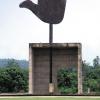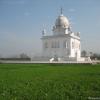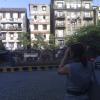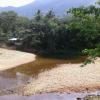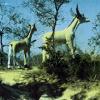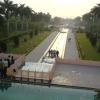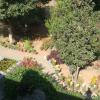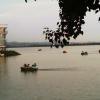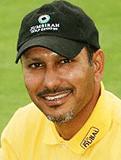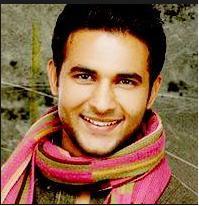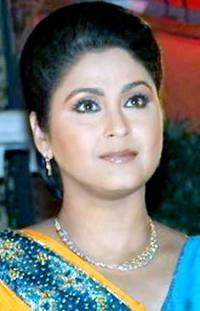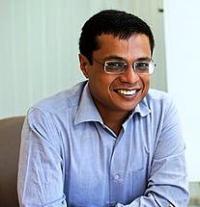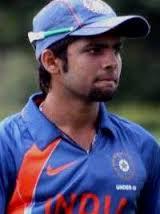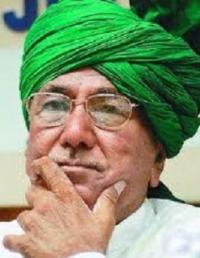Chandigarh is a Union Territory of India which also serves as the capital of two Indian states, Haryana and Punjab. This is the first planned city in India and is popular for its architecture. The name Chandigarh is derived from the name of the ancient temple located here called Chandi Mandir. This is the cleanest city in India as of 2010.
History of Chandigarh
When India got its independence in 1947, Punjab was split into two and Lahore which served as the capital of Punjab until that time was taken over by Pakistan. This gave the need to build a new capital for Punjab. This was initiated by the then Prime Minister of India, Jawaharlal Nehru and the work of modeling the city was entrusted with the architect Le Corbusier. The master plan was drawn by the architect from America named Albert Mayer. The city was established in 1953. When the state of Haryana was carved out of the eastern part of Punjab on 1st November 1966 on linguistic lines, Chandigarh became the capital of Haryana also.
Plan of Chandigarh
The master plan of Chandigarh was drawn similar to the human body. The capital complex is the head, the city center sector is the lungs, the cultural and educational institutions are the circulatory system and the industrial area is the viscera. The city was planned well with the leisure valley, gardens, sector greens, open courtyards, etc.
The Secretariat, the High Court and the Legislative Assembly are placed in the capital complex. The city center has the Inter State Bus Terminus, Parade Ground, District Courts and other buildings such as banks, offices and shops. 10% of the total area allotted in the first phase was meant for parks.
The city has a good layout of roads and there are seven main roads. The vertical roads are called the paths and the horizontal roads are called the margs. All these roads intersect at right angles and the city is thus planned to save the residential areas from the noise and pollution caused by road traffic.
The city is divided into four parts A, B, C and D and each sector occupies 250 acres of area. Some of the major institutions are located in the sectors 10, 11, 12, 14 and 26. A separate area of 2.35 square kilometers is allotted for the industrial area. The evergreen trees are planted along the roads, shopping complexes and residential areas which is also a part of city planning.
Map of Chandigarh

Geography and Climate of Chandigarh
Chandigarh spreads over an area of 114 square kilometers and is situated at an elevation of 1053 feet above mean sea level. It is surrounded by the regions of Panchkula and Ambala in Haryana and Mohali, Patiala and Roopnagar in Punjab.
Chandigarh has a humid subtropical climate with hot summers and mild winters. The temperature ranges between -1 degree Celsius and 41.2 degree Celsius. There are five seasons in Chandigarh, spring season from mid February to mid April, autumn season from mid September to mid November, summer season from mid May to mid June, monsoon season from mid June to mid September and winter season from November to mid March. The temperature of Chandigarh in winter ranges between 1 degree Celsius and 16 degree Celsius and the temperature of Chandigarh in summer ranges between 27 degree Celsius and 44 degree Celsius. The average annual rainfall of Chandigarh is 1110.7 mm.
People and Culture of Chandigarh
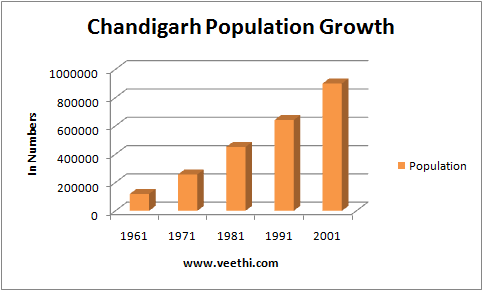
The population of Chandigarh as per the 2011 census is 960,787 with a density of 7900 people per square kilometers. The sex ratio is 1000 males for 829 females. This is the lowest in India. The average literacy rate of Chandigarh is 86.77%. Originally during the first phase, the city was meant to accommodate half a million people and so 30 sectors were constructed. However to cater to the additional population, the sectors from 31 to 47 were constructed during the second phase. The third phase is growing with sectors 48 and above. From 1991 to 2001 there is an increase of 40.33% in population and so the city is growing to accommodate the additional population.
Chandigarh being a cosmopolitan city reflects the different cultures of India. Folk music and dances of different communities are exhibited here. The two main languages spoken here are Hindi and Punjabi. English is also common among the younger generation.
Education in Chandigarh
There are many model schools in Chandigarh and some of the important educational institutions here are Punjab Engineering College, Government College of Art and Craft, Punjab University and Government Teacher Training College. Other institutions are Department of Biotechnology, Chandigarh College of Engineering and Technology, Chandigarh College of Architecture, Institute of Microbial Technology, Arena Animation Academy, etc.
Economy of Chandigarh
Chandigarh is the richest city in India with highest per capita income. The per capita income is 99,262 INR. As three governments are run from here, most of the people in the city are either working with any of them or retired from government services. So the city is also called Pensioner’s Paradise.
Chandigarh IT Park, Federation of Indian Chambers of Commerce and Industry, PHD Chamber of Commerce and Industry and Confederation of Indian Industry contribute to the growth of the city.
Chandigarh Transportation
Chandigarh Airport is a domestic airport and plans of extending to the international one are in progress. The new Chandigarh International airport is built over an area of 306 acres of land in Jheorehri Village near Mohali. Air India, GoAir, Jagson Airlines, Jet Airways, JetLite and Kingfisher Airlines connect Chandigarh with Delhi, Mumbai, Bangalore, Dharamsala, Kullu, Indore, Jaipur and Chennai.
Chandigarh Railway Station is located in its outskirts between Chandigarh and Panchkula. The railway station code is CDG. Chandigarh bus stand is located in sector 17. NH 22 connecting Ambala with Kinnaur and NH 21 connecting Chandigarh with Leh passes through the city. The Chandigarh Metro Rail project is under process.
Chandigarh Tourism
Chandigarh is a well planned beautiful city and has many parks and other recreational places. Some of them are listed below.
1. War Memorial
2. Le Corbusier Centre
3. Leisure Valley
4. Rajendra Park
5. Bougainvillea Park
6. Hibiscus Garden
7. Botanical Garden
8. Garden of Fragrance
9. Zakir Rose Garden
10. Terraced Garden
11. Sukhna Lake
12. Rock Garden
13. Shanti Kunj
14. Government Museum and Art Gallery
15. Chrysanthemum Garden
16. Garden of Annuals


